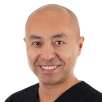Laser therapy is not a foreign concept to most dental practitioners as many practitioners include surgical lasers in their arsenal of high-tech equipment. Low-level lasers are a subset of the laser family that elicits a cellular response from the cell, as opposed to a photothermal effect, resulting in improved healing, pain reduction and a reduction in inflammation. Low-level lasers frequently use similar wavelengths to surgical lasers; however, use a significantly reduced power and a larger tip diameter.
Most surgical lasers include a detailed training programme to ensure the systems are used safely and correctly; however, one area that is frequently overlooked is how the surgical laser parameters such as the power, spot size or using a different component, can be modified to act as a low-level laser device. The Zolar surgical laser includes the bleaching wand handpiece, which has a tip of 4cm2 and power which can be reduced to 400mW, making it an efficacious alternative to a low-level laser device.
Mechanism of action
Low-level laser therapy (LLLT) works at the cellular level to stimulate the production of cellular energy in the form of adenosine triphosphate, or ATP. ATP can be thought of as the gasoline of the cell – it provides the energy needed to help a cell function effectively and repair itself.
embedImagecenter("Imagecenter_1_1634",1634, "large");
History of laser therapy
The use of light for healing and physical wellbeing is not a modern concept. For centuries, people have valued the healing nature of light and have historically used it in different forms of clinical therapies. Hospitals frequently took patients to the rooftops to help improve patient’s health and light therapy has been studied and used for decades to combat winter depression, or Seasonal Affective Disorder. When studies on light began in earnest in the 1950s, many researchers were sceptical of the safety of light devices, often proposing that any wavelength in the electromagnetic spectrum, similar to UV, would cause similar negative effects like cancer.
One such researcher, Dr Endre Mester, set out to investigate whether this hypothesis was correct and found that not only did the laser not cause cancer or cellular damage in his animal models; it actually stimulated the healing of wounds and the hair growth. This was one of the first documented demonstrations of the bio-stimulatory effects of light. Since then, thousands of in-vitro and in-vivo studies have been conducted on the use of laser therapy, which have been published in esteemed journals such as Nature, Pain and The Lancet. Further, laser therapy has been included in a number of evidence-based clinical guidelines for neck pain, Achilles tendinitis and rotator cuff injuries.
Safety
It is only cells that are deficient in or incapable of producing optimal amounts of ATP that will be affected by LLLT. Once the optimal amount of ATP is being produced, our cells use the enzymes called ATPases to cease the ongoing production of cellular energy. As such, healthy cells will be unaffected by laser light and thus there are no detrimental side effects to LLLT. This has been demonstrated repeatedly in literature and is a key factor in making it such an appealing treatment modality to an increasing number of healthcare professionals.
Using the appropriate dose
Treatment dose is probably the most important variable in laser treatment. Dose is measured in joules per square centimetre (J/cm²) and is a measure of the amount of energy that is conducted into the tissue. Clinicians should be aware of the optimal dose for each application to maximise the beneficial effects of laser therapy. Clinical effects of laser, such as wound healing, pain relief or muscle relaxation, are all sensitive to different irradiances or doses.
Clinical effects of LLLT
LLLT has been used effectively in dentistry for more than four decades, though the magnitude of the positive clinical effects has just started to be documented in double blind placebo controlled studies in the last ten years. Clinically, low-level laser therapy can be used as an adjunct to surgical laser procedures as well as a treatment adjunct to other dental treatments for numerous conditions and applications, some of which are noted below. This is best described by the Arndt Schultz principle which indicates that weak stimuli will increase physiological processes and strong stimuli will abolish physiological activity.
Post-extraction
Effects of LLLT:
- Reduction of post-op pain.
- Reduced need for analgesics.
- Increased circulation to get faster healing.
- Reduced post-op edema.
- Reduced probability of dry socket as a result of improved epithelial healing.
Dry socket
Effects of LLLT:
- Significant reduction in the acute and severe pain of the exposed socket nerves.
- Subsequent appointments - stimulation of fibroblasts for the production of an epithelial layer in the socket.
Dental infection
Effects of LLLT:
- Reduction of edema (swelling).
- Stimulates the immune system and brings neutrophils to site of infection for faster healing.
Soft tissue lesion (herpes lesions, apthous ulcers and denture sores)
Effects of LLLT:
- Reduction in pain.
- Prevention of lesion if caught in early stages.
- Faster healing.
- Decreased recurrence.
Restorative and cementing crowns
Effects of LLLT:
- Analgesia for small tooth preparations and crown cementations reducing use of local anaesthetic in these cases
- Reduction of post-op sensitivity.
- Faster uptake and elimination of anaesthesia.
- Production of secondary dentin in deep restorative situations.
Case study: Primary tooth restoration
A 20-month-old child presented with baby bottle caries in the upper anterior that needed to be restored. Normally, this patient would have been sent to a pedodontist to have the appointment done under sedation or general anaesthetic. However, in this case, the laser was applied to the apex and the restoration was completed with no anaesthesia. Laser application was well-received by the patient and the mother was thrilled that the appointment was so easy.
Nausea and gagging
Effects of LLLT:
- Application to the P6 acupuncture point decreases nausea and gagging.
Endodontics (following root canals, pulpotomies, endodontic surgery)
Effects of LLLT:
- Reduction of post-op pain and inflammation.
- Reduced need for post-op analgesics.
Case study: Diagnosis of irreversible pulpitis
A 42-year-old patient presented with a tooth ache in the upper right quadrant. She was unable to accurately identify which tooth was causing the pain and the x-ray didn’t show anything of significance. The laser was applied to the apex of each tooth until the patient felt a pain response, indicating the affected tooth. The laser was taken away for one minute to allow the inflammatory chemicals to drain and then reapplied to the affected tooth. Patient felt immediate pain, indicating it was a case of irreversible pulpitis. The tooth was removed at the patients request and pain disappeared completely.
Dentine hypersensitivity
Effect of LLLT:
- Reduction in the conduction of c-fibres, which carry pulpal pain.
- Stimulation of endorphins.
- Reduced inflammation.
- Stimulation of soft tissue healing.
Orthodontics
Effect of LLLT:
- Reduces intensity of pain.
- Increases speed of tooth movement because of stimulation of osteoblasts
Implants
Effects of LLLT:
- Reduction of pain after surgery.
- Faster integration of implant.
Case study: Implants
A patient presented with a cracked tooth that had abscessed over time. The patient was sent to an oral surgeon, who sectioned the tooth and removed some bone. The laser was applied immediately after extraction, both in the socket and along the suture line. The oral surgeon offered to prescribe Percocet for pain, but the patient declined and experienced no pain. Over the next three weeks, the laser was applied two times per week around the extraction site. Three months later, the patient returned to have an implant placed. At the time of surgery, the surgeon commented on the quality of bone at site. LLLT was applied both after the site was prepared and after the implant was placed, to the buccal and lingual surface. The patient experienced no post-operative pain and took no pain medications.
Sinusitis
Effects of LLLT:
- The laser can help to reduce the inflammation and congestion within the sinuses, which significantly reduces pain.
Nerve regeneration
Effect of LLLT:
- Return of sensation after traumatic damage or severing of a nerve.
Treatment tip:
- Apply twice weekly.
- May take up to 20 sessions.
- When patient feels tingling or burning of nerve, stop laser treatment and monitor progress.
Preventing trismus after long appointments
- Apply superiorly, cover the top of the masseter being sure it goes over the TM Joint (this ensures you are treating the joint and the lateral pterygoid).
- Treat the rest of masseter until you reach the lower border.
TMJ protocols
Submandibular lymphatics (Fig. 2).
Temporomandibular joint
Temporomandibular joint application (Fig. 8).
Styloid process
You are treating the joint capsule in the superior position and, in all three positions, you are treating the styloid muscles and ligaments as well as the posterior digastric muscle.
Sternocleidomastoid
This is treated at the sternal clavicular junction and anterior to mastoid area. If there are any trigger points in the body of the muscle, these should be treated being careful to angle the beam away from the thyroid gland.
Other Applications
The applications of laser therapy extend well beyond the dental chair. Ground-breaking research on wound healing, stroke, heart disease, neurological conditions and cancer are showing extraordinary results that could have a remarkably positive impact on medicine in the future.
Laser therapy is common in many other healthcare practices, with chiropractors, massage therapists, tissue injuries utilizing these devices as an adjunct to their current regime or as a prime treatment modality to ease the strain of these very physical careers. Clinical research on muscle repair and fatigue is of great interest to many athletes and their trainers, with extensive research being done to enhance the performance of elite athletes.
Conclusion
There are few options for healthcare practitioners for pain relief, reduction of inflammation and swelling and stimulation of wound healing that don’t involve pharmaceuticals with many detrimental side effects. Low-level laser therapy is non-invasive and non-toxic making it an attractive alternative to pharmaceuticals. What many dental practitioners are unaware of is how they can utilise their surgical laser devices that are frequent in most dental practices to utilise the amazing effects of low-level laser therapy.
Note: Approval is pending for using this application with Wand handpiece. Zolar Technologies has submitted to health Canada and is waiting for approval to sell for LLLT applications.
LAKE FOREST, Ill., US: BIOLASE, the globally recognised leader in dental laser technology, has launched its state-of-the-art all-tissue laser system, ...
LUCERNE, Switzerland: Slow Dentistry is a concept developed by a group of international clinicians in order to combat the pressure to perform and achieve ...
TRONDHEIM, Norway: A study conducted in Norway has provided valuable insights into the complex interplay between serum vitamin D levels and oral health ...
Even though people are increasingly aware that oral health is fundamental and strongly connected to our overall health, fear of the dentist is common. ...
NYON, Switzerland: The basis of good oral and general health is a clean mouth. Well-informed patients know this and visit the dentist for professional ...
NYON, Switzerland: Those who prioritise their overall health also understand the importance of oral health and consistently seek professional prophylaxis. ...
What do endodontic experts base their decisions on: intuition, experience or CBCT imaging? The following case report on a 10-year-old patient shows that an ...
NEW YORK, U.S.: When it comes to endodontic treatment, elimination of the microbial flora from the root canal system is a primary focus. In a free Dental ...
The demand for ceramic implants is steadily increasing. In a forthcoming webinar, on Wednesday, 8 April, Dr Joan Pi-Anfruns will explain how dentists can ...
Live webinar
Tue. 16 April 2024
3:00 pm EST (New York)
Live webinar
Wed. 17 April 2024
10:00 am EST (New York)
Live webinar
Wed. 17 April 2024
12:00 pm EST (New York)
Dr. Alexander Nussbaum Head of Scientific & Medical Affairs, Philip Morris GmbH, Dr. Björn Eggert
Live webinar
Wed. 17 April 2024
6:00 pm EST (New York)
Dra. Gabriella Peñarrieta Juanito
Live webinar
Thu. 18 April 2024
11:00 am EST (New York)
Live webinar
Mon. 22 April 2024
10:00 am EST (New York)
Prof. Dr. Erdem Kilic, Prof. Dr. Kerem Kilic
Live webinar
Tue. 23 April 2024
1:00 pm EST (New York)



 Austria / Österreich
Austria / Österreich
 Bosnia and Herzegovina / Босна и Херцеговина
Bosnia and Herzegovina / Босна и Херцеговина
 Bulgaria / България
Bulgaria / България
 Croatia / Hrvatska
Croatia / Hrvatska
 Czech Republic & Slovakia / Česká republika & Slovensko
Czech Republic & Slovakia / Česká republika & Slovensko
 Finland / Suomi
Finland / Suomi
 France / France
France / France
 Germany / Deutschland
Germany / Deutschland
 Greece / ΕΛΛΑΔΑ
Greece / ΕΛΛΑΔΑ
 Italy / Italia
Italy / Italia
 Netherlands / Nederland
Netherlands / Nederland
 Nordic / Nordic
Nordic / Nordic
 Poland / Polska
Poland / Polska
 Portugal / Portugal
Portugal / Portugal
 Romania & Moldova / România & Moldova
Romania & Moldova / România & Moldova
 Slovenia / Slovenija
Slovenia / Slovenija
 Serbia & Montenegro / Србија и Црна Гора
Serbia & Montenegro / Србија и Црна Гора
 Spain / España
Spain / España
 Switzerland / Schweiz
Switzerland / Schweiz
 Turkey / Türkiye
Turkey / Türkiye
 UK & Ireland / UK & Ireland
UK & Ireland / UK & Ireland
 Brazil / Brasil
Brazil / Brasil
 Canada / Canada
Canada / Canada
 Latin America / Latinoamérica
Latin America / Latinoamérica
 USA / USA
USA / USA
 China / 中国
China / 中国
 India / भारत गणराज्य
India / भारत गणराज्य
 Japan / 日本
Japan / 日本
 Pakistan / Pākistān
Pakistan / Pākistān
 Vietnam / Việt Nam
Vietnam / Việt Nam
 ASEAN / ASEAN
ASEAN / ASEAN
 Israel / מְדִינַת יִשְׂרָאֵל
Israel / מְדִינַת יִשְׂרָאֵל
 Algeria, Morocco & Tunisia / الجزائر والمغرب وتونس
Algeria, Morocco & Tunisia / الجزائر والمغرب وتونس
 Middle East / Middle East
Middle East / Middle East
:sharpen(level=0):output(format=jpeg)/up/dt/2024/04/Study-points-to-lack-of-formal-education-on-cannabis-in-dentistry.jpg)
:sharpen(level=0):output(format=jpeg)/up/dt/2024/04/Henry-Schein-appoints-three-new-executive-board-members.jpg)
:sharpen(level=0):output(format=jpeg)/up/dt/2024/04/Immediate-full-arch-zirconia-implant-therapy-utilising-the-power-of-robotic-assistance-and-digital-scanning_Fig-1-preophoto_title.jpg)
:sharpen(level=0):output(format=jpeg)/up/dt/2024/04/How-far-has-3D-printing-brought-clear-aligners.jpg)
:sharpen(level=0):output(format=jpeg)/up/dt/2024/04/Dentists-fear-DIY-tooth-extractions-as-Wales-hikes-NHS-fees.jpg)








:sharpen(level=0):output(format=png)/up/dt/2022/01/Straumann_Logo_neu-.png)
:sharpen(level=0):output(format=png)/up/dt/2020/02/Camlog_Biohorizons_Logo.png)
:sharpen(level=0):output(format=png)/up/dt/2011/07/fdi.png)
:sharpen(level=0):output(format=png)/up/dt/2013/01/Amann-Girrbach_Logo_SZ_RGB_neg.png)
:sharpen(level=0):output(format=png)/up/dt/2024/01/ClearCorrect_Logo_Grey_01-2024.png)
:sharpen(level=0):output(format=png)/up/dt/2014/02/Planmeca.png)
:sharpen(level=0):output(format=jpeg)/up/dt/2017/01/630de3eb69cb485562b271a8d1562510.jpg)

:sharpen(level=0):output(format=jpeg)/up/dt/2024/04/Study-points-to-lack-of-formal-education-on-cannabis-in-dentistry.jpg)
:sharpen(level=0):output(format=gif)/wp-content/themes/dt/images/no-user.gif)
:sharpen(level=0):output(format=jpeg)/up/dt/2024/02/New-all-tissue-laser-system-launched-by-BIOLASE-to-accelerate-adoption-of-lasers-in-dentistry.jpg)
:sharpen(level=0):output(format=jpeg)/up/dt/2019/10/Slow-Dentistry-seeks-to-change-pace-of-dental-care.jpg)
:sharpen(level=0):output(format=jpeg)/up/dt/2024/02/Broader-research-is-needed-to-connect-low-vitamin-D-levels-to-paediatric-caries-in-Norway-1.jpg)
:sharpen(level=0):output(format=jpeg)/up/dt/2023/12/Dentistry-reloaded-How-will-dentists-treat-Generations-Z-and-Alpha.jpg)
:sharpen(level=0):output(format=jpeg)/up/dt/2023/06/EMS_GBT.jpg)
:sharpen(level=0):output(format=jpeg)/up/dt/2023/12/EMS_GBT_INT-NL_07-12-2023__-AIRFLOW-MAX-Ortho.jpg)
:sharpen(level=0):output(format=jpeg)/up/dt/2019/01/Apical-lesions.jpg)
:sharpen(level=0):output(format=jpeg)/up/dt/2018/04/webinar-24.04.18.jpg)
:sharpen(level=0):output(format=jpeg)/up/dt/2020/04/How-to-attract-new-patients-by-offering-ceramic-dental-implants-1.jpg)







:sharpen(level=0):output(format=jpeg)/up/dt/2024/04/Study-points-to-lack-of-formal-education-on-cannabis-in-dentistry.jpg)
:sharpen(level=0):output(format=jpeg)/up/dt/2024/04/Henry-Schein-appoints-three-new-executive-board-members.jpg)
:sharpen(level=0):output(format=jpeg)/up/dt/2024/04/Immediate-full-arch-zirconia-implant-therapy-utilising-the-power-of-robotic-assistance-and-digital-scanning_Fig-1-preophoto_title.jpg)
:sharpen(level=0):output(format=jpeg)/wp-content/themes/dt/images/3dprinting-banner.jpg)
:sharpen(level=0):output(format=jpeg)/wp-content/themes/dt/images/aligners-banner.jpg)
:sharpen(level=0):output(format=jpeg)/wp-content/themes/dt/images/covid-banner.jpg)
:sharpen(level=0):output(format=jpeg)/wp-content/themes/dt/images/roots-banner-2024.jpg)
To post a reply please login or register